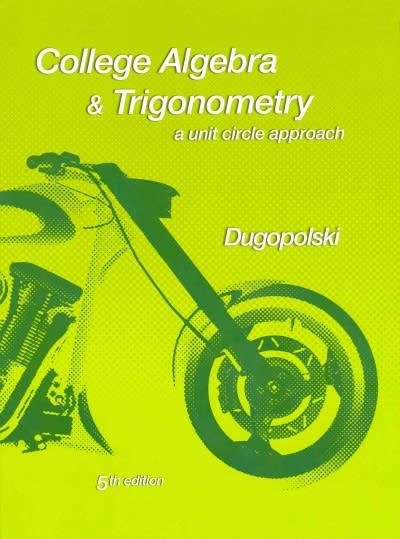Question
1 A human resources director claimed that 20% (0.20) of resumes contain outright lies, 30% (0.30) contain exaggerations, and only 50% (0.50) are completely honest.
| 1 | A human resources director claimed that 20% (0.20) of resumes contain outright lies, 30% (0.30) contain exaggerations, and only 50% (0.50) are completely honest. A random sample of 200 resumes showed that 20 contained outright lies, 60 contained exaggerations, and 120 were completely honest. Perform a hypothesis test at 95% confidence to determine whether the director's claim could be true. To get full credit state your null and alternate hypothesis, show how you calculated your test statistic, show your p-value, say whether you reject the null hypothesis, and state your conclusion: could the director's claim be true? YES or NO | |||
| 2 | An airline claimed that 60% (0.60) of their flights departed on time, 20% (0.20) were less than 15 minutes late, and 20% (0.20) were 15 or more minutes late. A sample of 120 flights showed 60 were on time, 30 were less than 15 minutes late, and 30 were 15 or more minutes late. Perform a hypothesis test at 95% confidence, to test whether the airline's claim could be true. To get full credit show your null and alternate hypothesis, show how you calculated your test statistic, and p-value, say whether you reject the null hypothesis, and state your conclusion: could the airline's claim be true? YES or NO | |||
| 3 | A school lunch planner claims the following is true: 15% (0.15) of students choose a salad lunch. 25% (0.25) of students choose a sandwich lunch. 30% (0.30) of students choose a hot lunch. 30% (0.30) of students bring a lunch from home. A random sample of 90 students showed the following sample data: 12 students in the sample chose a salad lunch. 25 students in the sample chose a sandwich lunch. 28 students in the sample chose a hot lunch. 25 students in the sample brought a lunch from home. Perform a hypothesis best at 95% confidence to determine whether the planner's claim could be true. To get full credit state your null and alternate hypothesis, show your test statistic and p-value, state whether you reject Ho, and state your conclusion: could the planner's claim be true? YES or NO | |||
| 4 | A psychiatric researcher ran a study to test the effectiveness of a drug to treat patients with obsessive-compulsive disorder (OCD). The subjects were randomly assigned to a treatment group (which received the drug) and a control group which received a placebo. Sample data is as follows: (You are expected to calculate the totals for each row and column.) | |||
| Treatment | ||||
| Experimental Drug | Placebo | Total | ||
| Improved | 50 | 25 | ||
| Not improved | 50 | 75 | ||
| Total | ||||
| Perform a hypothesis test at 95% confidence to determine whether the outcome (improved or not improved) is independent of the treatment (experimental drug or placebo). To get full credit state your null and alternate hypothesis, show your test statistic and p-value, state whether you reject Ho, and state your conclusion: is type of treatment independent of outcome (improved or not)? YES or NO | ||||
| 5 | A sports medicine researcher wants to know stretching before exercise reduces the chance of injury. Sample data is as follows: (You are expected to calculate the totals for each row and column.) | |||
| Stretched | Did not stretch | Total | ||
| Injury | 40 | 120 | ||
| No injury | 260 | 180 | ||
| Total | ||||
| Perform a hypothesis test at 95% confidence to determine if stretching is independent of getting injuries. To get full credit state your null and alternate hypothesis, show your test statistic and p-value, state whether you reject Ho, and state your conclusion: is stretching independent of injuries? YES or NO |
Step by Step Solution
There are 3 Steps involved in it
Step: 1

Get Instant Access to Expert-Tailored Solutions
See step-by-step solutions with expert insights and AI powered tools for academic success
Step: 2

Step: 3

Ace Your Homework with AI
Get the answers you need in no time with our AI-driven, step-by-step assistance
Get Started


